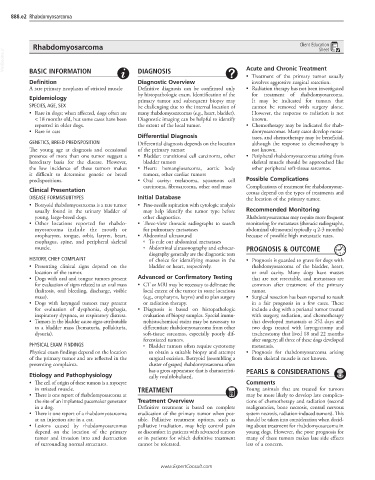Page 1767 - Cote clinical veterinary advisor dogs and cats 4th
P. 1767
888.e2 Rhabdomyosarcoma
Rhabdomyosarcoma Client Education
Sheet
VetBooks.ir Acute and Chronic Treatment
DIAGNOSIS
BASIC INFORMATION
• Treatment of the primary tumor usually
Definition Diagnostic Overview involves aggressive surgical resection.
A rare primary neoplasm of striated muscle Definitive diagnosis can be confirmed only • Radiation therapy has not been investigated
by histopathologic exam. Identification of the for treatment of rhabdomyosarcoma.
Epidemiology primary tumor and subsequent biopsy may It may be indicated for tumors that
SPECIES, AGE, SEX be challenging due to the internal location of cannot be removed with surgery alone.
• Rare in dogs; when affected, dogs often are many rhabdomyosarcomas (e.g., heart, bladder). However, the response to radiation is not
< 18 months old, but some cases have been Diagnostic imaging can be helpful to identify known.
reported in older dogs. the extent of the local tumor. • Chemotherapy may be indicated for rhab-
• Rare in cats domyosarcomas. Many cases develop metas-
Differential Diagnosis tases, and chemotherapy may be beneficial,
GENETICS, BREED PREDISPOSITION Differential diagnosis depends on the location although the response to chemotherapy is
The young age at diagnosis and occasional of the primary tumor: not known.
presence of more than one tumor suggest a • Bladder: transitional cell carcinoma, other • Peripheral rhabdomyosarcomas arising from
hereditary basis for the disease. However, bladder tumors skeletal muscle should be approached like
the low incidence of these tumors makes • Heart: hemangiosarcoma, aortic body other peripheral soft-tissue sarcomas.
it difficult to determine genetic or breed tumors, other cardiac tumors
predispositions. • Oral cavity: melanoma, squamous cell Possible Complications
carcinoma, fibrosarcoma, other oral mass Complications of treatment for rhabdomyosar-
Clinical Presentation comas depend on the types of treatments and
DISEASE FORMS/SUBTYPES Initial Database the location of the primary tumor.
• Botryoid rhabdomyosarcoma is a rare tumor • Fine-needle aspiration with cytologic analysis
usually found in the urinary bladder of may help identify the tumor type before Recommended Monitoring
young, large-breed dogs. other diagnostics. Rhabdomyosarcomas may require more frequent
• Other locations reported for rhabdo- • Three-view thoracic radiographs to search monitoring for metastases (thoracic radiographs,
myosarcoma include the mouth or for pulmonary metastases abdominal ultrasound typically q 2-3 months)
oropharynx, tongue, orbit, larynx, heart, • Abdominal ultrasound because of possible high metastatic rates.
esophagus, spine, and peripheral skeletal ○ To rule out abdominal metastases
muscle. ○ Abdominal ultrasonography and echocar- PROGNOSIS & OUTCOME
diography generally are the diagnostic tests
HISTORY, CHIEF COMPLAINT of choice for identifying masses in the • Prognosis is guarded to grave for dogs with
• Presenting clinical signs depend on the bladder or heart, respectively. rhabdomyosarcoma of the bladder, heart,
location of the tumor. or oral cavity. Many dogs have masses
• Dogs with oral and tongue tumors present Advanced or Confirmatory Testing that are not resectable, and metastases are
for evaluation of signs related to an oral mass • CT or MRI may be necessary to delineate the common after treatment of the primary
(halitosis, oral bleeding, discharge, visible local extent of the tumor in some locations tumor.
mass). (e.g., oropharynx, larynx) and to plan surgery • Surgical resection has been reported to result
• Dogs with laryngeal tumors may present or radiation therapy. in a fair prognosis in a few cases. These
for evaluation of dysphonia, dysphagia, • Diagnosis is based on histopathologic include a dog with a perianal tumor treated
inspiratory dyspnea, or respiratory distress. evaluation of biopsy samples. Special immu- with surgery, radiation, and chemotherapy
• Tumors in the bladder cause signs attributable nohistochemical stains may be necessary to that developed metastasis at 252 days and
to a bladder mass (hematuria, pollakiuria, differentiate rhabdomyosarcoma from other two dogs treated with laryngectomy and
dysuria). soft-tissue sarcomas, especially poorly dif- tracheostomy that lived 18 and 22 months
ferentiated tumors. after surgery; all three of these dogs developed
PHYSICAL EXAM FINDINGS ○ Bladder tumors often require cystotomy metastasis.
Physical exam findings depend on the location to obtain a suitable biopsy and attempt • Prognosis for rhabdomyosarcoma arising
of the primary tumor and are reflected in the surgical excision. Botryoid (resembling a from skeletal muscle is not known.
presenting complaints. cluster of grapes) rhabdomyosarcoma often
has a gross appearance that is characteristi- PEARLS & CONSIDERATIONS
Etiology and Pathophysiology cally multilobulated.
• The cell of origin of these tumors is a myocyte Comments
in striated muscle. TREATMENT Young animals that are treated for tumors
• There is one report of rhabdomyosarcoma at may be more likely to develop late complica-
the site of an implanted pacemaker generator Treatment Overview tions of chemotherapy and radiation (second
in a dog. Definitive treatment is based on complete malignancies, bone necrosis, central nervous
• There is one report of a rhabdomyosarcoma eradication of the primary tumor when pos- system necrosis, radiation-induced tumors). This
at an injection site in a cat. sible. Palliative treatment options, such as should be taken into consideration when decid-
• Lesions caused by rhabdomyosarcomas palliative irradiation, may help control pain ing about treatment for rhabdomyosarcoma in
depend on the location of the primary or discomfort in patients with advanced tumors young dogs. However, the poor prognosis for
tumor and invasion into and destruction or in patients for which definitive treatment many of these tumors makes late side effects
of surrounding normal structures. cannot be tolerated. less of a concern.
www.ExpertConsult.com

